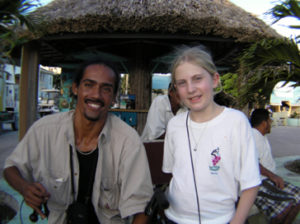Kurt was fussing over the last details on one of his paintings when the deafening tropical downpour stopped suddenly, as if to awaken him from a dream. Born and raised near the Guatemalan border in Belize, the 28-year-old artist created bright acrylic paintings of the tropical sea nearby. He sensed movement behind him. As he turned, a sharp pain stung his neck and back. He lost consciousness. When he awoke in the infirmary, he was paralyzed. An attacker’s knife had just barely nicked his spine, but he would never again feel the right side of his body. His life as an artist was over, the physician told him, nor would he walk again.
 But Kurt had other plans. He would thrash around with his hand over and over again until he could grab the window sill next to his bed. After a few weeks, he could raise his slender frame up high enough to see the ocean. Ten months of struggle put him back on his feet, although he would need crutches and patience to take even a few steps.
But Kurt had other plans. He would thrash around with his hand over and over again until he could grab the window sill next to his bed. After a few weeks, he could raise his slender frame up high enough to see the ocean. Ten months of struggle put him back on his feet, although he would need crutches and patience to take even a few steps.
Kurt is one of 800,000 people worldwide to get a little more mobility from a decade-old nonprofit started by Blackhawk developer Ken Behring and his sons, David and Jeff, near San Francisco, California. Volunteers from their Wheelchair Foundation have shipped and assembled chairs in dozens of countries. Donors contribute US$150 for a wheelchair that would cost over $1,000 here in the little village of San Pedro, Belize, south of Mexico.
My wife, Bonita, and my ten-year-old daughter, Vanessa, joined 48 California donors on this trip. We pulled wheelchairs from boxes, pumped tires, attached footrests and lifted people out of broken wheelchairs into new ones. Some had never even experienced a wheelchair. In Old Belize, gangs ruled the neighborhoods and thousands still live on dirt floors in rotting wood shacks without adequate electricity or sanitation. We saw a crocodile crawl through garbage in an open drain while children played soccer in the street a few steps away.
When we met Kurt yesterday, it had been two years since he’d been injured. He was proud to be an artist again. In a ceremony in the village’s tiny ‘Central Park’, on a bright, white, sandy beach, we presented him with a new chair–one of 280 recipients on this trip to Central America. Before the event, Kurt spread out a collection of aqua-colored 8×10 paintings done painstakingly with his twisted hand. He told the crowd: “I taught myself to paint with my left hand. I can’t feel the brush, but my eyes tell my fingers what to do.”
Kurt said that his art was an obsession, but it still was not enough to get him out of bed everyday. What moved him was the need to make a living and help people who are “less fortunate”– a concept that’s hard to imagine as you see him barely manage to stand in crutches. When he’s not painting, he collects clothes for pennies that he sells for a few dollars. This week’s profits helped buy medical care for a friend crippled in a drive-by shooting. Kurt is rushing to keep his pal’s immobile limbs alive with physical therapy. He’s also raising funds for surgery necessary to remove a bullet still lodged in his friend’s back before it becomes infected and deadly.
That’s what drives Kurt to go to great effort to get up each morning. “This very moment there is someone out there who needs you,” he said. “God gave me a second chance. He gave me a reason for living. Life is about feeling passion and feeling needed. I could stay in bed, but where would my friends be?”
YQ5C7JDM9G52
by Mark Thompson
SOURCE: Leader Power Tools

Leave a Reply
Want to join the discussion?Feel free to contribute!